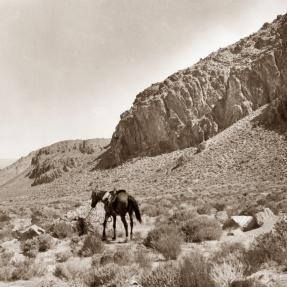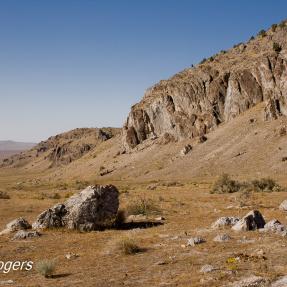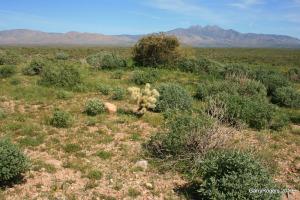Desert Fire
The pictures show a common scene across the Great Basin Desert: Replacement of shrubland by Cheatgrass (Bromus tectorum) and other Asian invasive plants.

1901. Cedar Mountains by G. K. Gilbert
Shrubland in the Great Basin Desert.
Great Basin shrubland replaced by fire-prone invasive weeds.
The left photo, taken by G.K. Gilbert in 1901, shows Great Basin desert shrubland. The right photo, taken by me in 2008, shows that fire-prone invasive weeds have replaced most native shrubs.
Near the start of the 20th Century, vegetation ecologists studying desert plant communities noticed a connection between wildfire and non-native weeds (Kearney et al. 1914). It soon became clear that some of the alien weeds encouraged fire spread by making a much more continuous fuel layer than native plants made. The aliens completed their life cycles and dried out by early summer. Through the summer and fall, naturally ignited lightening fires and human-caused fires became larger than they had before the alien weeds arrived.

Near Saguaro Lake, Arizona. Once diverse landscape of small trees and tall Saguaro cactus became impoverished shrubland after invasion by fire-prone plants.
Many scientists reported the danger posed by the alien weeds in the Great Basin desert (Leopold 1949, Hull 1965, Young et al. 1971, Rogers and Steele 1980, McLaughlin and Bowers 1982, Rogers 1980, Rogers 1986, Alford 2001, Rice et al. 2008). Land managers ignored the warnings. Now, a century later, more than half the native plant communities of the Great Basin are gone, replaced by Asian invasive plants (Reid et al. 2008). A similar cycle is spreading into the hotter deserts to the south (Turner et al. 2010).
The photo above shows a scene Jeff Steele and I studied (Rogers and Steele 1980). We were curious about recovery of this hot desert vegetation after a fire. Following a fire in 1974, we set out permanent plots and transects in burned and adjacent unburned vegetation. One of our transects passed through the scene in the photograph. The site, including the transect area, burned again in 1979. Before the 1979 fire, a dense stand of Teddy Bear Cholla (Opuntia biglovii) covered the foreground of the photograph. Only one of the bright thorny plants remains. Though I took the photo in winter, you can see the beginnings of the carpet of alien annuals surrounding the cactus.
Desert Fire Ecology
Native vegetation recovers from fire if the dominant plants have root systems that survive fire or if there is enough time for seeds to return to the burned area from surrounding unburned areas. For grasslands the time required is relatively short. Fires with average return intervals of around 10 years, keep the semidesert grasslands bordering the desert free of shrubs and trees (McPherson 1995, McPherson and Weltzin 2000, Turner et al. 2003). Fire return intervals of 20 to 50 years allow root-sprouting interior chaparral vegetation to recover (Schussman 2006b), and even longer intervals of a century or more allow recovery of Sonoran Desert vegetation (Rogers and Steele 1980, Rogers 1985, Schmid and Rogers 1988).
In the western U. S., increased fire size supported by invasive weeds has eliminated millions of acres of native vegetation (Young et al. 1971, West 1979, 1983, Rogers 1982, Schmid and Rogers 1988, Mack 1989, Anable et al. 1992, McPherson 2001, Brooks et al. 2004, Floyd et al. 2006).
Writing about invasive cheatgrass (Bromus tectorum) in the Great Basin, range scientist A. C. Hull summed it up this way, “the more cheatgrass the more fire, and the more fire the more cheatgrass” (Hull 1965: 23). Similar fire-weed cycles are expanding into the warm deserts where fires were rare before people brought the alien invasive weeds (Turner et al. 2010).
Fire as a Land Management Tool
During the 19th and early 20th Centuries, fuel reduction by livestock, and fire breaks created by roads probably reduced fire size and allowed an increase of trees and shrubs in semidesert grasslands surrounding the deserts (McPherson and Weltzin 2000). Land mangers often uses fire to remove woody plants, believing that this is a natural way to increase the native grasses preferred by cattle (e.g., McGee 1977, Bunting et al. 1987). Fire-prone invasive weeds changed the natural processes, but managers in the U. S. Bureau of Land Management and U. S. Forest Service continue to set fires to remove woody plants. The potential for fire to enable invasion by fire-prone weeds has made the use of fire to manage vegetation undesirable (Rogers 1985, D’Antonio 2000).
Outlook for Fire and Invasive Plants
Native vegetation and wildlife of North American deserts are being swept away by the fire-weed cycle (Mack 1989, Turner et al. 2010). None of the destructive land-management practices have changed. Livestock continue to destroy soil microorganisms and make room for invasive plants. Roads and recreation continue to do the same. Reestablishing and protecting native vegetation can cost more than $100,000 per acre. Replacing the cheatgrass in the Great Basin with native vegetation would cost as much as bailing out 10 large banks or supporting the U. S. military for 8 years. Since wealth is measured in dollars and not landscape health, the replacement will not occur before the land is washed into the sea, heaven burns, and hell freezes.
This is my sixth post concerned with weed invasion. The others introduce the problem and discuss the role of human disturbance, soil microorganisms, livestock grazing, and recreation in the invasion. Though I came late to the party (Rogers 1980), I saw the weed problem and dutifully reported it. It is disappointing that politics and the momentum of past practices have more control over land management than sound scientific evidence. Click here for a list of my posts on invasive weeds.
Desert Fire and Invasive Plants References
Alford, E. J. 2001. The effects of fire on Sonoran Desert plant communities. Dissertation, Ariz State Univ, Tempe, AZ. 109 p.
Anable, M.E. M. P. McClaran, G. B. Ruyle. 1992. Spread of introduced Lehmann lovegrass Eragrostis lehmannianaNees. in southern Arizona, U. S.A. Biological Conservation 61:181-188.
Brooks, M. L., C. M. D’Antonio, D. M. Richardson, J. B. Grace, J. E. Keeley, J. M. DiTomaso, R. J. Hobbs, M. Pellant, and D. Pyke. 2004. Effects of invasive alien plants on fire regimes. BioScience 54:677-688.
Bunting, S. C., B. M. Kilgore, and C. L. Bushey. 1987. Guidelines for prescribed burning sagebrush-grass rangelands in the northern Great Basin. Gen. Tech. Rep. INT-231. Ogden, UT: U.S. Department of Agriculture, Forest Service, Intermountain Forest and Range Experiment Station. 33 p.
D’Antonio, C. M. 2000. Fire, plant invasions, and global changes. Pages 65-93 in H. A. Mooney and R. J. Hobbs, eds. Invasive species in a changing world. Island Press, Washington, DC 457 p.
Floyd, M. L., D. Hanna, W. H. Romme, and T. E. Crews. 2006. Predicting and mitigating weed invasions to restore natural post-fire succession in Mesa Verde National Park, Colorado, U. S.A. International Journal of Wildland Fire 15:247-259.
Hull, A. C., Jr. 1965. Cheatgrass—a persistent homesteader. Pages 21-26 in Bureau of Land Management. Proceedings cheatgrass symposium. Bureau of Land Management, Oregon-Washington State Office. 92 p.
Kearney, T. H., L. J. Briggs, and H. T. Shantz. 1914. Indicator significance of vegetation in Tooele Valley, Utah. Agricultural Research 1:365-417.
Leopold, A. 1949. A Sand County almanac and sketches here and there. Oxford University Press, New York. 226 p.
Mack, R. N. 1989. Temperate grasslands vulnerable to plant invasions: Characteristics and consequences. Pages 155-179 in Drake et al., eds. SCOPE 37, biological invasions, a global perspective. John Wiley & Sons, New York. 506 p.
McGee, J. M. 1977. Effects of prescribed burning on a sagebrush ecosystem in northwestern Wyoming. Report. University of Wyoming and U.S. Department of Agriculture, Forest Service. 134 p.
McLaughlin, S., and J. Bowers. 1982. Effects of wildfire on a Sonoran Desert plant community. Ecology 63:246-248.
McPherson, G. R. 1995. The role of fire in the desert grasslands. Pages 130-151 in M. P. McClaran and T. R. van Devender, eds. The desert grassland. University of Arizona Press, Tucson, Arizona.
McPherson, G. R., and J. F. Weltzin. 2000. Disturbance and climate change in United States/Mexico borderland plant communities: a state-of-the-knowledge review. Gen. Tech. Rep. RMRS-GTR-50. Fort Collins, CO: U.S. Department of Agriculture, Forest Service, Rocky Mountain Research Station. 24 p.
McPherson, G. R. 2001. Invasive plants and fire: integrating science and management. Pages 141–146 in K.E.M. Galley and T.P. Wilson (Eds.). Proceedings of the Invasive Species Workshop: the Role of Fire in the Control and Spread of Invasive Species. Fire Conference 2000: the First National Congress on Fire Ecology, Prevention, and Management. Miscellaneous Publication No. 11, Tall Timbers Research Station, Tallahassee, FL.
Reid, C. R., S. Goodrich, and J. E. Bowns. 2008. Cheatgrass and redbrome; the history and biology of two invaders. Pages 27-32 in S. G. Kitchen, R. L. Pendleton, T. A. Monaco, and J. Vernon, comps. Proceedings-Shrublands under fire: disturbance and recovery in a changing world; 2006 June 6-8; Cedar City, UT. Proc. RMRS-P-52. Fort Collins, CO: U.S. Department of Agriculture, Forest Service, Rocky Mountain Research Station. 190 p
Rice, P. M., G. R. McPherson, and L. J. Rew. 2008. Fire and nonnative invasive plants in the interior west bioregion. Pages 140-174 in Zouhar, K., J. K. Smith, S. Sutherland, and M. L. Brooks. 2008. Wildland fire in ecosystems: Fire and nonnative invasive plants. U. S. Forest Service, Rocky Mountain Research Station, General Technical Report RMRS-GTR-42-Vol. 6. Ogden, UT. 355 p.
Rogers, G. 1980. Photographic documentation of vegetation change in the Great Basin Desert. PhD Dissertation. University of Utah Geography Department, 160 p.
Rogers, G. 1982. Then and Now: A Photographic History of Vegetation Change in the Central Great Basin Desert. University of Utah Press, Salt Lake City, UT. 188 pp.
Rogers, G. 1983. Influences of Alien Plants on Arid Vegetation Dynamics. Ecological Society of America Symposium: Causes and Consequences of Invasions of Alien Annual Plants in Western North America. Logan, UT.
Rogers, G. 1985. Mortality of burned Cereus giganteus. Ecology 66:630‑632.
Rogers, G. 1986. Comparison of fire occurrence in desert and nondesert vegetation in Tonto National Forest, Arizona. Madroño 33:278-283.
Rogers, G. and J. Steele. 1980. Sonoran desert fire ecology: Adaptive strategies of perennial plant species. U.S. Forest Service, General Technical Report RM‑81:15‑19.
Schmid, M., and G. Rogers. 1988. Trend in fire occurrence in the Arizona Upland subdivision of the Sonoran Desert. Southwestern Naturalist 33:437-444.
Schussman, H. 2006. Historical range of variation and state and transition modeling of historical and current landscape conditions for interior chaparral of the southwestern U.S. Prepared for the U. S. D. A. Forest Service, Southwestern Region by The Nature Conservancy, Tucson, AZ. 24 pp.
Turner, R. M, R. H. Webb, J. E. Bowers, and J. R. Hastings. 2003. The changing mile revisited, an ecological study of vegetation change with time in the lower mile of an arid and semiarid region. University of Arizona, Tucson, Arizona, U. S.A. 334 p
Turner, R.M., R. H. Webb, T. C. Esque, and G. F. Rogers. 2010. Repeat photography and low elevation fire responses in the southwestern United States. Pages 223-244 in R. H. Webb, D. E. Boyer, and R. M. Turner, eds. Repeat photography methods and applications in the natural sciences. Island Press, Washington DC. 337 p.
West, N. E. 1983. Great Basin—Colorado Plateau sagebrush semi-desert. Pages 331-349 in N. E. West, ed. Ecosystems of the world 5: Temperate deserts and semi-deserts. Elsevier Scientific Publishing Company, New York. 522 p.
Young, J. A., R. A. Evans, and J. Major. 1971. Alien plants in the Great Basin. Journal of Range Management 25:194-201.

